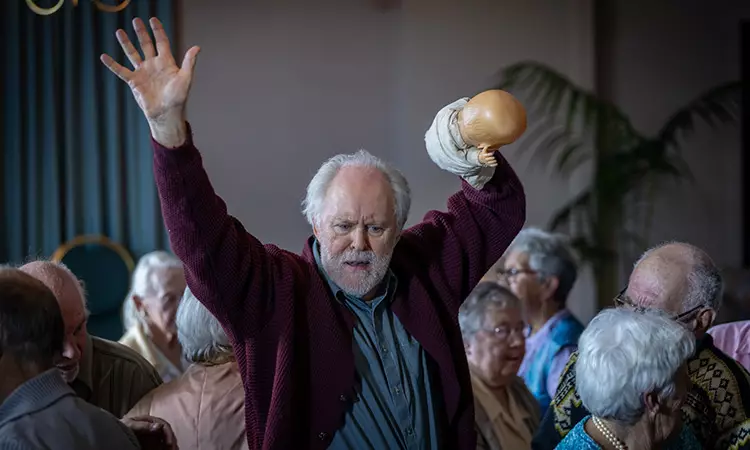In the realm of psychological horror, few narratives delve as profoundly into the unsettling interplay between vulnerability and tyranny as the upcoming film “The Rule of Jenny Pen,” adapted from Owen Marshall’s short story. At the heart of this haunting tale lies Judge Stefan Mortensen, portrayed by the legendary Geoffrey Rush. After a crippling stroke confines him to a retirement home, Mortensen’s grim reality unfolds. This story not only mirrors our societal perceptions of aging but also reveals the darker aspects present in the care facilities meant to provide comfort to the elderly.
What sets “The Rule of Jenny Pen” apart from other horror narratives is its raw exploration of vulnerability. Typically, aging is portrayed in cinema as a gentler transition marked by reflection and peace. However, Owen Marshall’s work subverts this trope by placing its protagonists in a setting rife with antagonism and psychological horror. Mortensen’s character, ostensibly arrogant and unreachable, undergoes a metamorphosis as he confronts his new, terrifying reality, particularly through his unsettling interactions with fellow resident Dave Crealy, played masterfully by John Lithgow. Their relationship evokes the chilling nature of social hierarchies that can persist even in the twilight of life.
Childlike Innocence Tainted by Cruelty
Central to the film’s tension is the concept of innocence corrupted; it’s embodied in the sinister game known as “The Rule of Jenny Pen,” a cruel pastime that unearths the psychological terror lurking within what should be a nurturing environment. Lithgow’s character, armed with a dementia doll, champions this leaden game that traps not just Mortensen but the entire community of residents in a cycle of torment. Instead of experiencing their final years in peace, the elderly characters find themselves victims of sadism draped in the guise of playfulness.
The film’s setting—an ostensibly safe haven for the elderly—transforms into a microcosm of societal corruption. This portrayal resonates with the audience, tapping into fear not just of the physical decay that accompanies aging but also of the psychological decline that occurs in the absence of respect and kindness. The film deftly handles the topic of bullying, carefully parallel to both childhood and elder abuse, presenting a chilling reminder that vulnerability knows no age.
The Weight of Authority and Autonomy
One of the most compelling elements of “The Rule of Jenny Pen” is how it tackles the loss of autonomy—a theme profoundly resonant within the horror genre. Director James Ashcroft has astutely noted that tyranny can emerge from the most unexpected places, providing a colorful but alarming lens through which to view the dynamics between residents and caretakers alike. The unassuming surroundings of a retirement home become the breeding ground for a chilling hierarchy where the old continue to experience the torment of domination.
Ashcroft emphasizes that this narrative does not seek to demonize care facilities, but rather to shine a light on the quiet horrors that can transpire behind closed doors. The meticulous training provided to the film’s cast brings authenticity to the portrayal of care within these institutions. This allows the audience to engage not just with the emotional journey of the characters but also with the stark realities faced by both residents and caregivers. In the demanding atmosphere of underfunded care homes, where the staff is stretched thin and the emotional weight overwhelming, the film presents a nuanced depiction of a world often overlooked.
Agricultural Metaphor for Subversion
At its core, “The Rule of Jenny Pen” serves as a metaphorical examination of society’s treatment of the vulnerable. This horror narrative evolves into an allegory about tyranny woven through the fabric of aging. The chilling dynamics between the characters urge the audience to confront uncomfortable truths about authority and helplessness that can resonate on a societal level. Ashcroft’s interpretation of Marshall’s story takes us through these themes delicately, encapsulating our collective fears about aging, respect, and dignity in care.
Throughout the film, the tension escalates, and Mortensen finds himself compelled to take action when the staff fails to address the horrors around him. This central arc underscores the importance of agency, especially in an environment that traditionally strips individuals of their autonomy. The horror becomes acutely personal, encouraging audiences to empathize with the struggle against not just the external threat of Crealy, but also the internal fear of losing one’s individuality and dignity in the twilight years of life.
As “The Rule of Jenny Pen” approaches its release, it rings as an urgent reminder to protect those who are vulnerable and to recognize the often unseen battles waged in care facilities. This film not only invites viewers to reflect on the horrors present in the marginalization of the elderly but also compels us to confront our own responsibilities towards our aging loved ones. It is a haunting yet necessary exploration that promises to linger long after the credits roll, challenging the perceptions we have about aging, care, and the dynamics that govern our final years.

